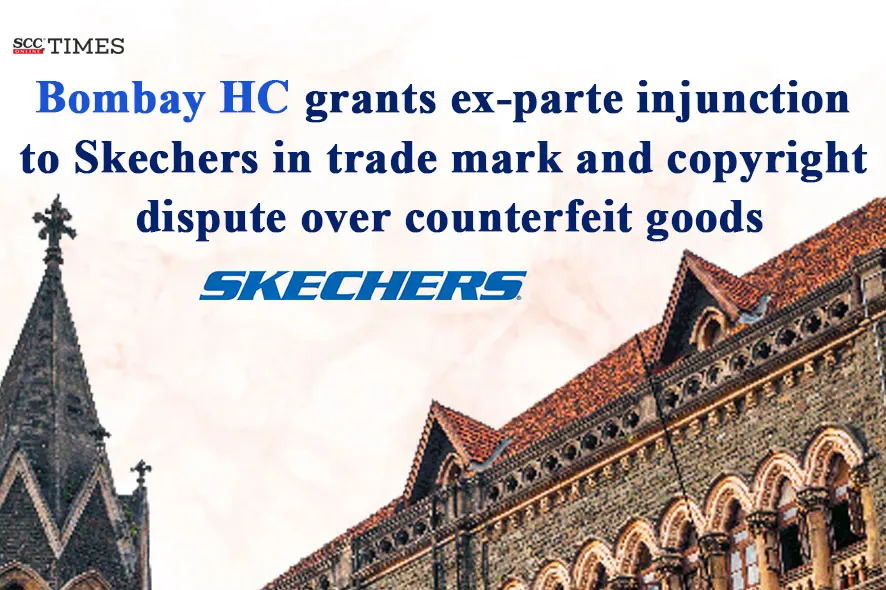Bombay High Court: In the present interim application, Skechers South Asia (P) Ltd. (‘plaintiffs’) filed a suit against Manmeet Singh Trading (‘defendant’), alleging infringement of trade mark and copyright through counterfeit goods bearing Skechers’ registered marks and artistic works. To prevent further harm, the plaintiffs sought an ex-parte ad-interim injunction and appointment of a Court Receiver.
A Single Judge Bench of Arif S. Doctor, J., while granting an ex-parte ad-interim injunction restraining the defendants from using Skechers’ trade marks and artistic works on counterfeit goods, held that there was a strong prima facie case for infringement of trade marks and copyright had been made out by the plaintiffs. The Court emphasised that the adoption of the plaintiffs’ trade marks and artistic works in relation to the impugned goods by the defendants was completely dishonest.
Background:
The case arose from a suit filed by the plaintiffs for infringement of trade mark and copyright concerning their registered marks, SKECHERS (word per se), ![]() /
/ ![]() /
/ ![]() / HYPER ARC, ARCH STEP and associated artistic works such as
/ HYPER ARC, ARCH STEP and associated artistic works such as ![]() /
/ ![]() /
/ ![]() / HYPER ARC, ARCH STEP and associated artistic works such as
/ HYPER ARC, ARCH STEP and associated artistic works such as ![]() /
/ ![]() /
/ ![]() /
/ ![]() /
/ ![]() /
/ ![]() and
and ![]() . The plaintiffs also alleged passing off but were not pressing that relief at the time, as leave under Clause XIV of the Letters Patent (Bombay) was not yet obtained. At that stage, the plaintiffs were seeking reliefs for trade mark and copyright infringement and the appointment of a Court Receiver.
. The plaintiffs also alleged passing off but were not pressing that relief at the time, as leave under Clause XIV of the Letters Patent (Bombay) was not yet obtained. At that stage, the plaintiffs were seeking reliefs for trade mark and copyright infringement and the appointment of a Court Receiver.
The trade mark ‘SKECHERS’ was adopted around 1992 for footwear and related services. Plaintiff 2 designed and marketed Skechers-branded lifestyle and performance footwear, apparel, and accessories. Plaintiff 3, a wholly owned subsidiary of Plaintiff 2, was the owner of the Skechers trade marks and logos and had licensed them to Plaintiff 1 for use in India. Accordingly, all goodwill from such use accrued to Plaintiff 3. The plaintiffs also created artistic works with distinct fonts of writing such as ![]() /
/ ![]() /
/ ![]() /
/ ![]() /
/ ![]() /
/ ![]() /
/ ![]() and claimed copyright ownership. Further, the promotional materials and social media screenshots, along with sales and marketing data from 2012—2013 onward, and specimen invoices were duly exhibited. It was contended that the plaintiffs had actively protected their rights, with prior court orders.
and claimed copyright ownership. Further, the promotional materials and social media screenshots, along with sales and marketing data from 2012—2013 onward, and specimen invoices were duly exhibited. It was contended that the plaintiffs had actively protected their rights, with prior court orders.
In the last week of September 2025, an investigator hired by the plaintiffs discovered goods at the defendants’ premises in Punjab bearing the plaintiffs’ trade marks and artistic works. Upon examination, the plaintiffs found the goods to be counterfeits, imitating their products in quality, materials, stitching, and pricing. The action was treated as a John Doe suit since the manufacturer’s identity remained unknown. It was alleged that the plaintiffs searched the Trade Marks Registry under Class 25 but found no applications by defendants and moreover, the start date of their infringing activities remained unknown.
The plaintiffs submitted that the defendants had copied their trade marks and artistic works, making the impugned goods identical or deceptively similar, and that those were counterfeits. They argued the defendants acted dishonestly and that giving notice would risk the removal or sale of the infringing goods. Hence, they sought an ex-parte ad-interim injunction to restrain further infringement.
Analysis and Decision:
The Court observed that, prima facie, the plaintiffs were the registered proprietors of the plaintiffs’ trade marks SKECHERS / ![]() /
/ ![]() /
/ ![]() / HYPER ARC / ARCH STEP, and were the owners of copyright subsisting in the plaintiffs’ Artistic Works
/ HYPER ARC / ARCH STEP, and were the owners of copyright subsisting in the plaintiffs’ Artistic Works ![]() /
/ ![]() /
/ ![]() /
/ ![]() /
/ ![]() //
// ![]() .
.
The Court emphasised that from the impugned goods shown in the plaint, it appeared that the defendants’ Impugned Goods were absolute counterfeits. The Court highlighted that the defendants had bodily lifted the plaintiffs’ trade marks and the plaintiffs’ artistic works and had applied the same to the impugned goods. The Court held that the adoption of the plaintiffs’ trade marks and the plaintiffs’ artistic works in relation to the impugned goods by the defendants was completely dishonest.
The Court found that a strong prima facie case for infringement of trade marks and copyright had been made out by the plaintiffs. The Court noted that the balance of convenience was also in favour of the plaintiffs. The Court further observed that, unless the reliefs sought for were granted, the plaintiffs would suffer or were likely to suffer irreparable harm, loss and injury. Further, the Court was satisfied that giving notice to the defendants before passing the present order would defeat the very purpose of granting ad-interim reliefs.
In these circumstances, the Court directed that there should be an ad-interim order in terms of prayer clauses (a), (b), (d) and (e) of the Interim Application. The Court clarified that the order would not prevent the defendants from selling original/legitimate goods upon which the plaintiffs’ trade marks and the plaintiffs’ artistic works had been affixed by the plaintiffs or any other person authorised by the plaintiffs, if any, sourced from legitimate sources. However, the order would apply to all other products, bags, invoices, signboards, material bearing the plaintiffs’ trade marks and the plaintiffs’ artistic works which were not authorised by the plaintiffs and/or were counterfeits.
The Court further clarified that insofar as prayer clause (d) was concerned, the Advocates and/or authorised representatives of the plaintiffs were to accompany the Additional Special Receivers appointed therein at the time of execution of the order and assist the Additional Special Receivers in identifying all counterfeit and/or unauthorised products, packaging material or such other material which alone was to be seized and sealed.
The Court, thus, appointed the Court Receiver, High Court, Bombay with all powers under Order XL Rule I and Order XXXIX Rule 7 of the Civil Procedure Code, 1908 (‘CPC’), except the power of sale. The Court Receiver was directed to visit and search all premises of the defendants, forcibly breaking open locks if necessary and taking police assistance where required to seize and seal all offending goods including cartons, dyes, moulds, printing equipment and material carrying the impugned packaging, label, or trade dress, and to make an inventory of all such material and equipment.
Accordingly, the Court directed the plaintiffs to comply with Order 39 Rule 3 of the CPC within 14 days of execution and to submit a digital copy to the Court Receiver within five days of its availability. The Court also granted liberty to the defendants to seek variation or recall of the order upon giving seven clear working days’ notice. Furthermore, the reports from the Additional Special Receivers were due by 08-12-2025, and the report from the Court Receiver was due by 16-12-2025. The Interim Application was next listed for hearing on 17-12-2025, and the order shall remain in force until 19-12-2025.
[Skechers South Asia (P) Ltd. v. Manmeet Singh Trading, 2025 SCC OnLine Bom 4047, decided by 10-10-2025]
Advocates who appeared in this case :
For the Plaintiffs: Hiren Kamod a/w Smriti Yadav, Shubham Shende, Shubham Singh i/b Khaitan & Co.



